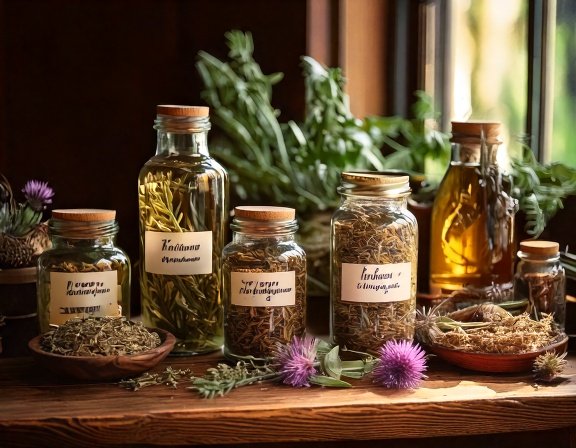Milk Thistle: Beautiful Detox Plant to Grow in Your Backyard

Freebie: 3-Day Gentle Detox Plan
Why Grow Milk Thistle?
Milk thistle is one of the most beneficial herbs you can grow for natural liver support and overall detox wellness. Known for its striking purple blooms and spiny leaves marked with white veins, this resilient plant is as beautiful as it is medicinal. For centuries, milk thistle has been prized for its ability to protect and regenerate liver cells—making it a foundational herb for anyone seeking to cleanse the body gently and restore internal balance.
The seed’s active compound, silymarin, is a potent antioxidant that helps shield the liver from toxins, supports bile production, and promotes tissue repair. Growing your own milk thistle ensures a pure, chemical-free source of this healing seed while also attracting pollinators and adding texture to your garden. It thrives in full sun, tolerates dry soil, and reseeds easily, making it a low-maintenance yet high-reward addition to your herbal garden.
Whether harvested for teas, tinctures, or homemade capsules, milk thistle offers powerful cleansing and protective properties that strengthen the body’s natural detox pathways. In this section, we’ll explore how to cultivate, harvest, and use milk thistle to promote long-term liver health and overall vitality.
Quick Tip: Grow milk thistle alongside other liver-supportive herbs like dandelion, burdock, and parsley for a synergistic “detox garden” that nourishes both body and soil.
Fun Fact: Milk Thistle gets its name from the white, milk-like veins on its leaves, which legend says resulted from the Virgin Mary’s milk falling on the plant.


Planting Milk Thistle at Home
Planting milk thistle at home is simple and rewarding—perfect for anyone looking to grow a hardy, low-maintenance herb that supports liver health and natural detox. With its tall stalks, spiky leaves, and striking purple flowers, milk thistle not only provides potent medicinal seeds but also adds beauty and biodiversity to your garden. It grows well in most climates, tolerates poor soil, and thrives with minimal care once established.
Step 1: Choose the Right Spot
Select a sunny location with well-draining soil. Milk thistle loves warmth and light—aim for at least 6 hours of direct sunlight per day. Though it tolerates poor soil, enriching it with compost before planting will boost growth and seed production.
Step 2: Sow Seeds
Plant milk thistle seeds directly outdoors in spring after the last frost, or start them indoors 4–6 weeks earlier. Sow seeds about ¼ inch deep and space plants 18–24 inches apart. Water gently and keep the soil lightly moist until seedlings appear—usually within 10–14 days.
Step 3: Watering & Growth
Once established, milk thistle requires very little water. Let the soil dry slightly between waterings, as overly wet conditions can cause root rot. Its deep taproot helps it thrive even in dry spells.
Step 4: Maintenance
Remove competing weeds and consider wearing gloves when handling the plant—it has sharp spines along the leaves and stems. If you want to prevent self-seeding, harvest the flower heads before they release their fluffy seeds.
Step 5: Companion Planting
Milk thistle pairs well with other hardy detox herbs such as dandelion, burdock, and yarrow. Together, they create a resilient, pollinator-friendly garden that supports both soil and body health.
Quick Tip: If you’re short on space, milk thistle can also be grown in deep containers. Choose pots with drainage holes and place them in full sun for a compact, manageable version of this healing powerhouse.
Gardener’s Tip
Caring for Milk Thistle Plants
Milk thistle is a resilient and low-maintenance herb, making it an excellent choice for both beginner and experienced gardeners. With just a little attention, it will reward you with tall, striking blooms and nutrient-rich seeds packed with liver-protective compounds. The key to caring for milk thistle is mimicking its natural environment—warm, sunny, and slightly dry conditions with well-drained soil.
Light & Temperature:
Milk thistle thrives in full sun, needing at least 6 hours of direct light daily. It tolerates a wide temperature range and can handle mild droughts once established. In cooler climates, it grows best during the warmer months but can reseed itself and return year after year.
Soil & Watering:
Plant milk thistle in moderately fertile, well-draining soil. Overly rich or compacted soil can encourage excessive foliage instead of strong seed production. Water young plants regularly until established, then reduce watering—let the top inch of soil dry out between waterings to prevent root rot.
Pruning & Maintenance:
Remove faded flowers to encourage new blooms or to control self-seeding. If you’d like to save seeds, allow some flower heads to dry completely on the plant before harvesting. Wear gloves when handling—its spines can be sharp!
Pests & Common Issues:
Milk thistle is naturally pest-resistant, though it may attract aphids or spider mites in hot, dry weather. Simply rinse leaves with a gentle stream of water or use a diluted neem oil spray to keep pests under control.
Seasonal Care:
After the growing season, trim plants back and collect seeds for replanting next year. Store seeds in a cool, dry place in paper envelopes or glass jars. In mild climates, milk thistle may overwinter and return naturally in spring.
Quick Tip: Milk thistle self-seeds easily—if you don’t want it spreading, cut flower heads before the white fluff (seed down) forms. Controlled harvesting ensures you’ll have both beauty and balance in your herbal garden.
Gardener’s Tip
Active Ingredient: Silymarin, a potent antioxidant compound, highly valued for protecting and regenerating liver cells.

Harvesting and Preparing Milk Thistle
Harvesting milk thistle is a rewarding process that gives you access to one of the most powerful liver-supportive herbs available. The seeds—found inside the spiky flower heads—are the most valuable part of the plant, rich in the antioxidant compound silymarin, which helps protect and regenerate liver cells. With proper timing and careful handling, you can harvest and prepare your own seeds for teas, tinctures, or supplements that nourish the liver and promote whole-body wellness.
When to Harvest:
Milk thistle seeds are ready to collect when the flower heads turn brown and dry, and the fluffy white tufts (similar to dandelion seeds) begin to appear. This usually occurs about 3–4 weeks after the flowers have bloomed. Harvesting before the seeds disperse ensures you capture their full potency and prevents unwanted self-seeding in your garden.
How to Harvest:
Wearing gloves, cut the dried flower heads from the plant and place them in a paper bag. Let them sit for about a week in a dry, shaded area to finish drying completely. Once dry, gently break apart the heads over a large bowl to release the seeds. Discard the sharp chaff and collect the smooth, gray-brown seeds for storage or immediate use.
How to Prepare for Use:
Before using, lightly crush or grind the seeds in a mortar and pestle or coffee grinder to release the beneficial oils and make the nutrients more bioavailable. Whole seeds can be steeped into teas or decoctions, while powdered seeds work well in smoothies, capsules, or tinctures. For herbal infusions, simmer 1–2 teaspoons of crushed seeds in water for 10–15 minutes to extract their liver-protective compounds.
Storage:
Store dried or ground milk thistle seeds in airtight glass jars, away from heat, moisture, and direct sunlight. When properly stored, they retain their potency for up to a year. Avoid plastic containers, as oils in the seeds can degrade plastic over time.
Quick Tip: Always harvest on a dry day and wear gloves to protect against the plant’s sharp spines. If you want to prevent milk thistle from spreading, remove flower heads before they open fully and release their fluffy seeds.
Gardener’s Tip
Fun Fact: Milk Thistle has been used medicinally for over 2,000 years, dating back to ancient Greece and Rome for liver and digestive ailments.
Milk Thistle Remedies for Detox and Liver Health
Milk thistle has been used for centuries as a trusted herbal remedy for cleansing and protecting the liver—the body’s main detox organ. Its seeds contain silymarin, a potent antioxidant compound that helps regenerate liver cells, neutralize toxins, and support bile production for healthy digestion. Whether you use it in teas, tinctures, or tonics, milk thistle works gently yet powerfully to restore balance, energy, and vitality from within.
Quick Tip: For best results, use milk thistle consistently but gently—1–2 servings daily for 2–3 weeks during seasonal detox periods. Pair with hydration, rest, and nourishing foods to enhance its cleansing effects without depleting energy.

Reverse Your Fatty Liver 100% Naturally
- Focuses on whole-food nutrition, natural detox, and science-backed protocols
- Incorporates plant-based remedies and gentle lifestyle changes
- Learn practical steps for liver health—no risky drugs or crash diets
- NIH National Center for Complementary and Integrative Health – Milk Thistle
- American Botanical Council – Milk Thistle Monograph
- Plants for a Future – Silybum marianum